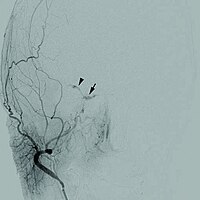Cerebrovascular disease

Cerebrovascular disease is a very big and long name for something that affects your brain. These big words are actually made up of two parts - cerebro and vascular. Cerebro means "relating to the brain" and vascular means "relating to the blood vessels". So cerebrovascular disease is when there is something wrong with the blood vessels in your brain.
To understand this, we first need to know that the brain is the most important part of our body. It controls everything we do, like talking, moving, and even thinking. But the brain needs blood to work properly. Blood carries oxygen and nutrients to the brain, which is like food and water for the brain.
Now, if the blood vessels in the brain get damaged or blocked, the brain wouldn't get enough oxygen or nutrients, which can cause damage or even death to the brain cells. This is what happens during cerebrovascular disease.
The most common types of cerebrovascular disease are stroke and transient ischemic attack (TIA). A stroke happens when a blood vessel in the brain gets blocked or bursts, and this prevents blood from reaching parts of the brain. This can cause serious damage to the brain, like paralysis, difficulty speaking or understanding, or even death. A TIA is like a mini-stroke, where the blood vessel is blocked only for a short while, but it still can cause symptoms similar to that of a stroke.
Cerebrovascular disease can happen to anyone, but it is more common in older people or those who have high blood pressure, diabetes, or heart disease.
In summary, cerebrovascular disease is a big name for a condition in which the blood vessels in the brain are damaged or blocked. This can cause strokes or mini-strokes, which can be very serious and even deadly. It is important to take good care of our brain and blood vessels by eating healthy, exercising, and seeing a doctor regularly.
To understand this, we first need to know that the brain is the most important part of our body. It controls everything we do, like talking, moving, and even thinking. But the brain needs blood to work properly. Blood carries oxygen and nutrients to the brain, which is like food and water for the brain.
Now, if the blood vessels in the brain get damaged or blocked, the brain wouldn't get enough oxygen or nutrients, which can cause damage or even death to the brain cells. This is what happens during cerebrovascular disease.
The most common types of cerebrovascular disease are stroke and transient ischemic attack (TIA). A stroke happens when a blood vessel in the brain gets blocked or bursts, and this prevents blood from reaching parts of the brain. This can cause serious damage to the brain, like paralysis, difficulty speaking or understanding, or even death. A TIA is like a mini-stroke, where the blood vessel is blocked only for a short while, but it still can cause symptoms similar to that of a stroke.
Cerebrovascular disease can happen to anyone, but it is more common in older people or those who have high blood pressure, diabetes, or heart disease.
In summary, cerebrovascular disease is a big name for a condition in which the blood vessels in the brain are damaged or blocked. This can cause strokes or mini-strokes, which can be very serious and even deadly. It is important to take good care of our brain and blood vessels by eating healthy, exercising, and seeing a doctor regularly.
